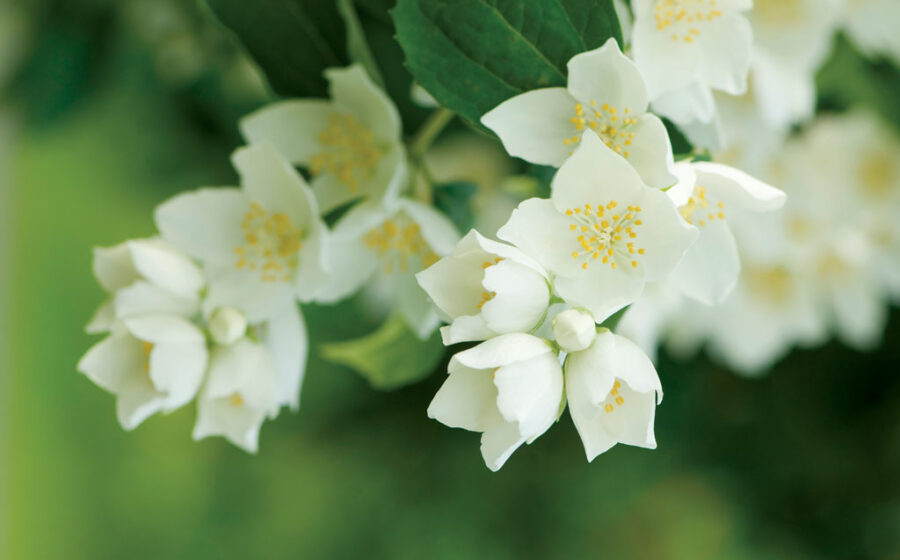[T]here is something beguiling about jasmine tea. In a quality cup, the scents of tea and flowers intertwine so blissfully that we might envision them as one plant, picked, harvested, and steeped to create the flowery brew. So how do leaves and petals become one? When is jasmine a luxuriant treat with an intoxicating aroma, and when is it a clever mask for poor quality? Unsurprisingly, like with most great inventions, the truth usually lies somewhere in between. A voyage into its harvest—and processing—reveals much.
Though they remain predominantly Chinese in origin, having hit their initial stride in popularity during the Ming Dynasty, jasmine-scented teas are now popular the world over, their floral aroma well favored by Western palates. Jasmine tea can vary in both the tea used—typically green or white—and processing method, but is ideally the result of a traditional scenting method dating back for several centuries. Quality can range from high-grade teas made of top-quality leaves, carefully prepared through a traditional, petal-and-leaf layering process, to lower quality teas fragranced using quick scenting methods like extract of jasmine, or even synthesized aroma. To those well-versed in the jasmine tea spectrum, traditional methods will have a distinctly sweet and gentle fragrance, while artificially flavored jasmine teas may be sharp and harsh.
Mature, fragrant jasmine blossoms are harvested in daylight, after the plant’s night blooms have closed back up and any overnight moisture has dissipated.
Harvesting the essentials for jasmine tea is a two-phase journey. First, the tea leaves that form the base—most commonly grown in the high mountains of China, and most famously in Fujian province—must be harvested, typically in spring. These fresh leaves are readied after plucking, as they will be waiting a few months for the company of their friends the jasmine flowers. Arabian jasmine is the most popular for use with tea, and won’t bloom until the warm evenings of late summer. How the tea leaves themselves are prepared will vary—in Fujian province, for instance, the leaves are dried over indirect heat, left in mostly flat shape so that they may make more overall contact with the jasmine petals when they come along.
The leaves are then carefully kept in storage until perfume-breezy jasmine season. Mature, fragrant jasmine blossoms are harvested in daylight, after the plant’s night blooms have closed back up and any overnight moisture has dissipated. They’re then brought inside the tea factory and kept in warm conditions where they are allowed to almost—but not completely—open again. Then the scenting can begin.
Scenting processes can involve simply mixing the tea leaves and the jasmine petals together and allowing them to rest for a period of time, or may involve elaborate layering of tea leaves, then jasmine petals, then leaves again and so on, with the height of the layers determined by the teamaker. Within these mixed piles, heat will begin to build up.
The mixture of layered leaves will be left out for a number of hours, until the teamaker’s target temperature is reached—upwards of 110 degrees Fahrenheit. The base tea will slightly oxidize during the process. After a target temperature is reached, the piles will be made smaller, cooled, and re-piled, and the layering process may be repeated numerous times, with fresh flowers, over days and even weeks to ensure the optimal transfer of fragrance to the tea leaves.
Once the scenting is complete, the flowers are usually removed—though not always—and the tea is dried again. In teas where jasmine petals are removed before packaging, it is customary to include a few whole flowers in the tea for decorative purposes. A year’s new jasmine teas will be available for purchase by mid-autumn (though it should be noted, they can keep for a few years.)
Culturally, jasmine tea holds as esteemed a place on many tea-lovers’ shelves as the essential category of unscented teas, from green to white to oolong to black. You’ll find jasmine teas of lower quality, where a poorly derived fragrance is used to conceal a lower grade of tea, and you’ll also find highest-quality silvery budded white teas, scented with exquisitely harvested flowers. Jasmine dragon pearls, a rolled jasmine-scented tea, holds its fragrance in tightly-wrapped, bead-shaped leaves, which provide both a dramatic reveal of flavor and a picturesque unrolling of the leaf when infused.
Though jasmine teas can vary in their base tea, scenting style, and shape, lovers of these teas seek them out for the soothing qualities in their aromas, as a traditional offering of welcome to guests, or as a companion beverage to lively foods. However you bring jasmine tea into your life, whether for relaxation or alongside a spicy meal, take a moment next time to appreciate how its elegant botanical history unfolded before it reached your cup.
—Liz Clayton is a beverage writer and editor based in Brooklyn.
















